Imagine if you looked up one day and a quarter of the employees at your company were suddenly gone. They weren’t laid off and the business was still in good shape financially, but one of every four workers was no longer on the staff. How would that change the way work gets done? How would you keep up with demand? How long would the business remain healthy?
Businesses in almost every industry across Wisconsin are facing the possibility of losing large numbers of employees to retirement in the coming years and in many cases, the departures have already started. More than 23 percent of the state’s workforce is older than 55, a figure that’s more than doubled in the past 20 years and reaches as high as 30 percent in some sectors.

The departure of that many people from the workforce will create plenty of challenges for employers as they seek to find their next generation of talent. At the same time, technology continues to place greater demands on the required skill levels of those workers.
The conversation around workforce has been shifting from just building up the state’s current labor pool to now also attracting new talent to the state. Tricia Braun, chief operating officer of the Wisconsin Economic Development Corp., said there’s been growing demand in the economic development community to address talent attraction at a state level.
Department of Workforce Development secretary Ray Allen put it a little differently.
“Workforce is the new economic development,” he said.
Buckley Brinkman, executive director and CEO of the Wisconsin Center for Manufacturing and Productivity, said the optimistic forecast is for the state workforce to be flat over the next 15 years, while the pessimistic version shows it could be down by 40 percent. Either way, there are examples of companies turning away work because they don’t have the workforce they need, Brinkman said.
“That might be fine for an individual company, but when you start adding those companies together, you have an economy that’s not growing,” he said.
There are plenty of efforts to bring more people into the workforce, whether they’re convicted criminals reentering society after serving their sentences, individuals with disabilities or people from high unemployment areas.

However, “we can bring all those people into the workforce and the arithmetic still doesn’t work,” Brinkman said.
He’s also skeptical efforts to attract more residents to the state will be enough.
“You’re bucking a North versus South trend we’ve been losing since the invention of air conditioners,” Brinkman said.
Brinkman sees investments in new technology as the way for manufacturers in particular to overcome their workforce challenges. But he’s concerned that many small and medium manufacturers aren’t making those investments.
At the same time, businesses and local organizations are doing the best they can to attract new employees and retain the ones they have. That means engaging with the community, partnering with schools, offering unique perks, opening satellite offices, utilizing remote work, providing flexible scheduling and leveraging technology.
Preparing for the future
The looming demographic challenges were among the main reasons organizations in Sheboygan County launched the “Someplace Better” campaign, said Dane Checolinski, director of the Sheboygan County Economic Development Corp.
The campaign aims to attract more people to live and work in Sheboygan County. It deliberately plays up opportunities in the area, like quality schools and outdoor recreation, while downplaying ideas of a rural or wintry location.
Checolinski said the feedback has been positive in the first year of Someplace Better. Most of the traffic on the campaign’s website goes to the job board, which he said gets more than 100 hits per day, with about 40 percent from outside the county.
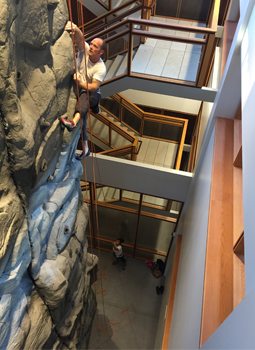
Sheboygan County is emblematic of the looming workforce challenges. The proportion of its workforce older than 55 is slightly higher than the state as a whole; it had an unemployment rate of 3.1 percent in December; and major employers like Acuity Insurance and Kohler Co. have been growing.
Sheboygan-area companies have been investing resources into the education system, raising millions for new manufacturing and engineering education space at the Sheboygan high schools and providing training opportunities for students. Checolinski said the number of youth apprenticeship participants has gone from around 30 five years ago to nearly 130 today.
Cassie Zinkel, senior manager of talent sourcing at Kohler, said looking at staffing needs over the next year is a weekly conversation for the company’s recruiting teams.
“We’re really taking a proactive approach in trying to stay ahead of that as much as we can,” she said.
The company is working with technical colleges and high schools to make sure training is aligned with company needs. It also opened new offices in Milwaukee and Chicago to expand the pool of administrative and professional talent.
“Not everybody needs to be here (in Kohler) all the time,” she said.
Kohler already had some flexible work arrangements, but 2016 marked the implementation of an actual policy related to those situations. It came with guidance and training for managers on dealing with remote employees. Zinkel said whether someone is successful in that environment often comes down to communication and their results.
Just a few miles away from Kohler, at Acuity Insurance, the solution to today’s workforce needs began almost accidentally 18 years ago by supporting a spelling bee. Besides generating goodwill in the community, sponsoring events like spelling bees, chess tournaments, math competitions and Junior Achievement gives the company a chance to expose students to the world of insurance and Acuity itself, said Ben Salzmann, president and CEO of Acuity.
“We want the kids coming here when they’re in the second grade, third grade, fourth grade (and so on),” he said.
Salzmann said about a year-and-a-half ago, a young woman was interviewing for a job at Acuity. Asked why she wanted to work there, she pulled out a T-shirt from an Acuity-sponsored spelling bee and described how the event helped to shape her interests along the way.
“Now we have this pipeline where we have these people coming in,” Salzmann said. “You show up at a college campus, it’s too late.”
That doesn’t mean Acuity doesn’t recruit on college campuses. The insurer recently piloted a program in which one of its fleet vehicles was wrapped in its latest ad campaign and sent to a handful of Wisconsin campuses. The team cooked bacon to draw the attention of students and then guaranteed anyone who submitted a resume a phone interview.
Acuity has been doing plenty of hiring, adding roughly 700 new people in the past five years, many of them new college graduates. Salzmann believes starting with increased community involvement almost two decades ago helped the company find enough talent.
Salzmann noted the insurance industry has particularly stringent job requirements, with the need for licensed accountants, actuaries and high-level computer programmers.
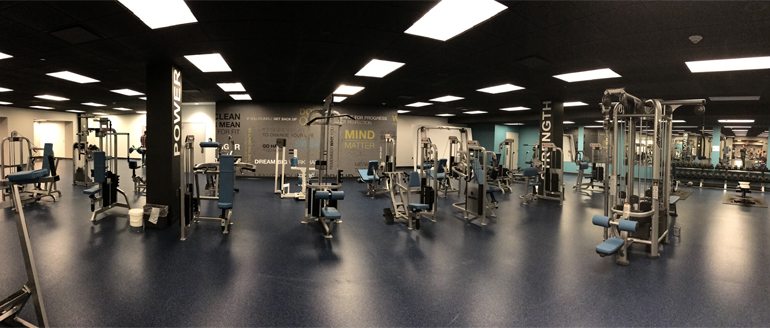
“There are unforgiving skill requirements we have to have,” he said, adding that technology has driven the skill requirements of the industry higher.
At the same time, Salzmann said experts expect half of the insurance industry to retire in the next five to 10 years.
“We can’t hire experienced insurance people; they ain’t there,” he said.
Instead, the company has to turn to new graduates and so far, has been able to fill its needs mostly from within Wisconsin.
“There is a real talent drain out of the state, so we’re always competing to keep people in Wisconsin,” Salzmann said.
Just as Acuity is reaching out to the state’s universities, Rose Oswald Poels, president and CEO of the Wisconsin Bankers Association, said community banks are increasing their outreach to technical colleges and four-year schools to find talent.
Like many industries, technology has changed the way banking is done. But unlike manufacturing, where workforce challenges and productivity pressures have pushed the adoption of new technologies, banking has seen consumer preferences and new technologies drive workforce changes.
Options like remote deposit for both businesses and consumers mean fewer tellers working behind the counter. Backroom operations have changed, too, shifting away from employees processing checks to automation.
“It’s changing the mix of employees that we have,” said Oswald Poels, noting banks have had to staff up in areas like compliance and information technology.
But there’s still a need for banks to serve as counselors to their customers and that means “technology cannot replace every human position.”
“It’s very much a trusted relationship that bankers have with their customers,” she said. “We still are very much a service-focused business.”
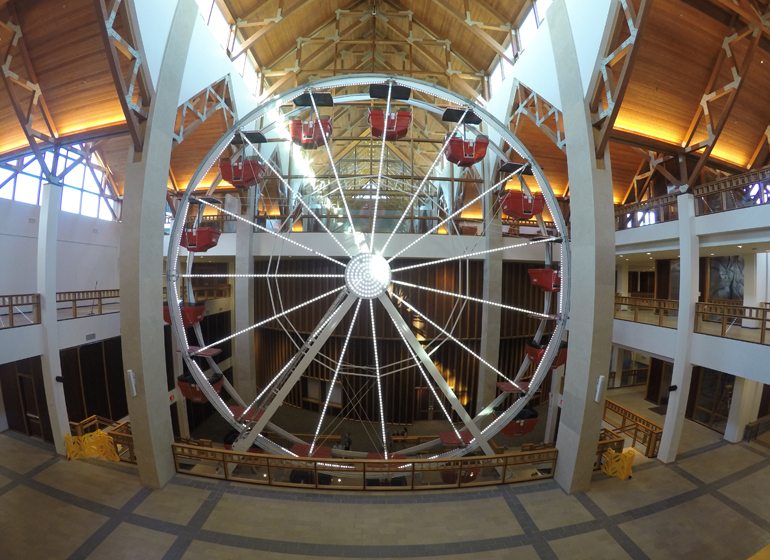
Keeping that service focus means having the right people in place, and Oswald Poels said there are concerns about finding talent in the future.
Like banking, technology is changing the workforce needs of the health care industry. Advances in technology have made outpatient procedures out of conditions that used to require an inpatient stay, said Eric Borgerding, president and CEO of the Wisconsin Hospital Association.
The aging population provides an additional burden on the health care industry in the state. It not only takes away from the health care workforce, more than one-third of Wisconsin nurses are over the age of 55–it also also adds to the demands on the health care system. George Quinn, executive director of the Wisconsin Council on Medical Education and Workforce, said telemedicine will help leverage limited resources for physicians in all specialties, while efficiency gained through consumer use of e-health, changes in workflow and increased use of remote care are expected to moderate the demand for physician services and ease the expected shortage.
Quinn said the rising use of technology means physicians need to be more adept at using it. Medical schools and residency programs already are incorporating technology throughout their curriculum. It helps that the youngest generations have grown up with technology.
Improving attraction and retention
Keeping students and residents in Wisconsin is a challenge for the entire state, not just one company or industry. Between 2005 and 2015, Wisconsin experienced a net loss of more than 61,000 residents to other states, according to U.S. Census Bureau estimates. Wisconsin’s top net loss states from 2005-’15 include Florida, Arizona, Texas and Georgia. Wisconsin had a net loss of more than 100,000 residents to those states over that time.

Retaining residents in Wisconsin and attracting new ones is at the center of the new “Think. Make. Happen.” initiative launched by the WEDC.
“Even if we retained every single person … we would still need to recruit,” Braun said.
WEDC surveys show Wisconsin needs to change perceptions about opportunities available in the state.
“The low-hanging fruit is obviously the Midwest population centers,” Braun said, noting those areas share a number of industries and a similar work ethic. The agency’s research found 49 percent of millennials in surrounding states would consider moving to Wisconsin.
She also said the state could tap into the alumni networks of its universities and specific companies know there are areas with surplus talent they can target.
The initiative is still gathering partners from around the state and one of the early findings is people don’t want the state to hide from its history in agriculture and manufacturing.

“If we are going to be successful with this, we have to be honest with who we are and we don’t want to shy away from it,” she said. “But we’re also a place where innovation happens every day.”
Braun noted the hard work of actually recruiting new residents is still to come and there will be competition.
“We’re not the only state having this challenge,” she said.
If Midwest population centers are the target, there’s already plenty of migration happening between Wisconsin and states like Illinois and Minnesota. Wisconsin had a net gain of more than 99,600 residents from Illinois between 2005 and 2015. Migration to and from Minnesota and Wisconsin essentially balanced out over that period, but an estimated 392,000 made the move one way or the other.
Braun and others say the state’s universities represent one of the best vehicles for attracting new residents.
University of Wisconsin-Milwaukee chancellor Mark Mone and Mike Knetter, chief executive officer of the University of Wisconsin Foundation, both said recruitment of students is important at their schools as the number of high school graduates in Wisconsin declines.
“We have put additional resources into recruitment,” Mone said, noting some of those resources are specifically targeted in Illinois “because their education system is so challenged right now.”
About 90 percent of UWM’s students are Wisconsin residents, while 5 percent are international and 5 percent come from other states, primarily in the Midwest. Mone doesn’t see UWM reaching a point where 20 or 25 percent of students are from out of state, but there are growth opportunities.
At UW-Madison, about two-thirds of the undergraduates are from Wisconsin. Knetter said the university recently launched a program called Wisconsin PRIME, which targets state high school seniors through personalized outreach by the chancellor, deans and faculty.

Whether they’re from the state or not, once students are at a Wisconsin university, their chances of staying are increased if they connect with Wisconsin companies through internships. Allen said the DWD is working on the development of an internship portal, similar to the Job Center of Wisconsin, where students can see internship opportunities and upload their resumes.
Knetter said about 70 percent of the internships UW students complete are with Wisconsin companies.
Mone, who was in charge of internship placements when he was in the business school, said it is important to get students into the world of work “as soon as they can.”
He also stressed the role of partnerships with companies like Snap-on Inc., GE Healthcare, Rockwell Automation Inc. and Johnson Controls International PLC on new products or other research.
“Those partnerships provide students with the opportunities to see how innovation makes such a difference,” he said.
Partnerships between industry and education aren’t just happening at the university level – they’ve also played an important role at technical colleges and in the K-12 system.
Allen said the majority of businesses “fully understand” the need to be involved in shaping the state’s future workforce. DWD and the state have had great partners in the Wisconsin Manufacturers & Commerce and local chambers, he said.
“From our standpoint, the private sector has engaged with us in a very collaborative effort,” Allen said.
Partnering with education
One executive who has been particularly involved in collaborating with the education system is Eric Isbister, CEO of Mequon-based metal fabricator GenMet. Even though the skills gap has been a frequent point of discussion at manufacturing events for years, he said there still is a need for more involvement throughout the industry.
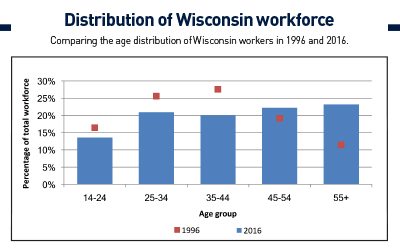
“Quite frankly and bluntly, if manufacturers don’t get off their ass and start talking to young people and getting young people excited about going into this, then it’s not going to happen,” he said. “Manufacturing is going to happen and if we don’t do it, somebody else will.”
Along with his wife, Mary (the company’s president), Isbister has been among the most vocal advocates raising awareness about the skills gap and exposing middle and high school students to careers in manufacturing.
For Eric, it started by looking at a graph of the age of his workforce. He could see the wave of retirements coming. The retirements are now becoming reality, evidenced by the company uniforms hanging on the wall at GenMet like retired jersey numbers hanging from the rafters of an arena.
Knowing the demographic shift was coming helped push Isbister to get involved with schools. More than 2,220 students have toured his facility, scrap material often is sent to high schools for students to use, employees know they’re expected to be ambassadors for the industry and the company fabricates student-designed parts for robotics competitions.
Isbister planned to attend three career fairs in February and part of his message to students was the number of careers available to them in manufacturing, noting the need for engineers and IT professionals. He’ll often ask a group of students how many like shopping; when many of the girls raise their hands, he points out he has someone on staff in charge of millions of dollars in purchases every year. He also points out all six of the manufacturers on his street off Donges Bay Road have the same talent needs.
As a metal fabricator, GenMet faces plenty of competition from others in the region. That competition means prices are pretty close and lead times become a determining factor, which is pushing the growth of automation and more advanced machines, Isbister said.
“The goal would be to automate more so that you can bring your parts-per-hour up and quote down and therefore, we’re more competitive,” he said.
Advancing machine capabilities is nothing new. After Isbister bought GenMet in 1999, he invested in a new, more productive laser cutting system. At the time, the company had a journeyman fabricator who felt the system was a threat to his job and made his feelings known in the shop.
“The business was a $3 million business at the time, and if we were going to stay a $3 million business and we were going to automate, sure, (the journeyman fabricator) was right – don’t need the people, don’t need the overtime – but we quadrupled the size of the business,” Isbister said. “Unfortunately, he continued with that attitude and he had to leave.”
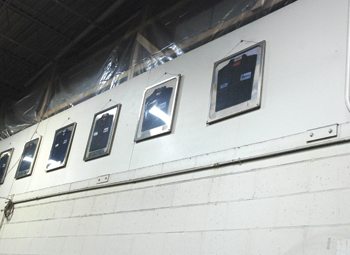
There are plenty of examples in manufacturing of companies using automation to become more productive and competitive. David Gazzo, CEO of Felss Rotaform LLC, said at a recent Waukesha County Business Alliance luncheon that in 2010, his company paid out $1.4 million in wages to 44 employees and did about $10 million in sales. By 2015, sales had doubled to $20 million and wages were $3.1 million, but there were just 49 employees.
“It was through automation and through efficiencies that we could increase the sales without really increasing the number of employees, but what we really increased was the pay,” he said.
Not only did Felss invest in higher wages, but also in retaining its employees. It starts with competitive wages and includes profit-sharing and a 401(k) match, but the other perks, including trips to Green Bay Packers games and other company celebrations, make the company stand out.
“We have almost like a department of entertainment in our company; it’s like a circus,” Gazzo said.
He’s often told he does too much, but feels the company needs to do more to attract and retain employees, because it is still difficult to find second- and third-shift workers.
At Fairchild Equipment, a Green Bay-based distributor of material handling equipment, training and transparency are at the heart of employee attraction and retention. Van Clarkson, Fairchild southern region president, said the company is expecting a quarter of its field staff to retire in the next five years.
Clarkson’s challenge is that he’s replacing 30-year veterans with millennial employees who could not be more different from those exiting the business, with a greater emphasis on flexible hours and clearly defined career paths.
Fairchild seeks to allow technicians to control their own pay by tying it to training, with three levels of pay – $15 to $19.99 per hour; $20 to $24.99; and $25-plus – based on training completed. Employees then have the chance to move into new or aftermarket sales, and eventually into management. New hires also work with a mentor for 90 days to help them identify deficiencies. Clarkson said training new technicians and making them feel comfortable within the company has resulted in almost zero turnover.
“We need to do the same thing everywhere,” he said, suggesting every position would have a similar structure in the near future.
Retention also is bolstered by being transparent with financial performance, allowing employees to see topline results, costs and profits, Clarkson said.
“You start educating people and treating them like they’re business people, they’re bought in,” he said.
Even with the number of retirements increasing, Clarkson said he’s not interested in hiring just anyone or in drawing employees from other firms.
“I will take my time to find the right employees as opposed to just plugging them in,” he said.

